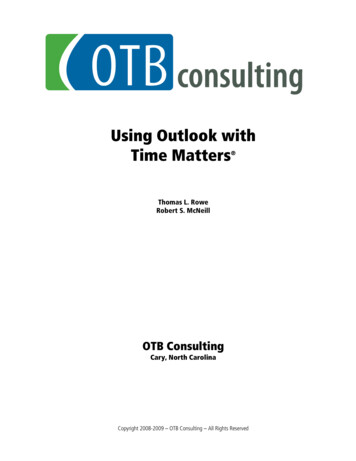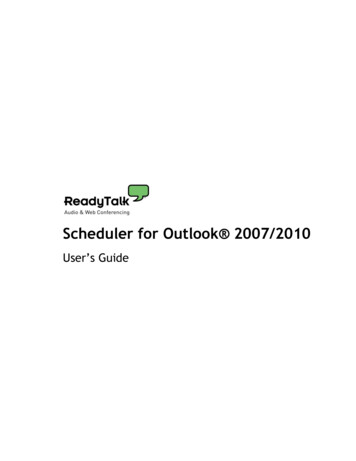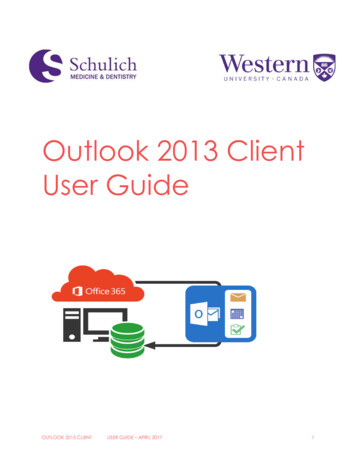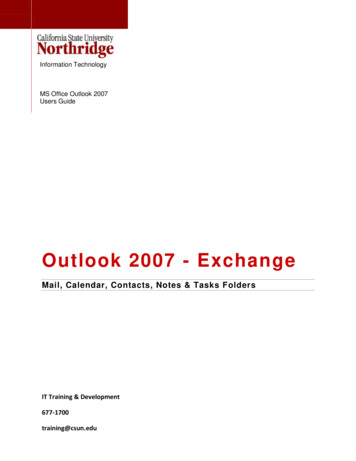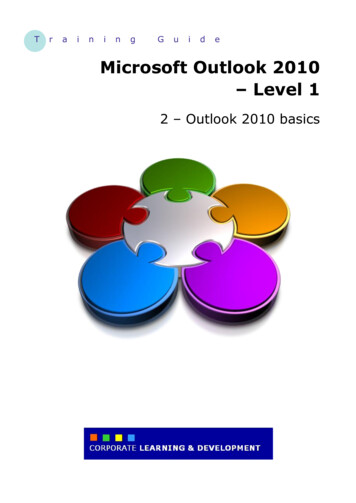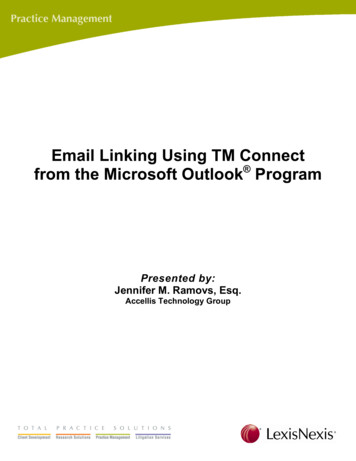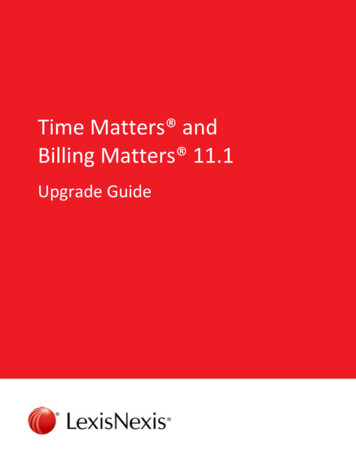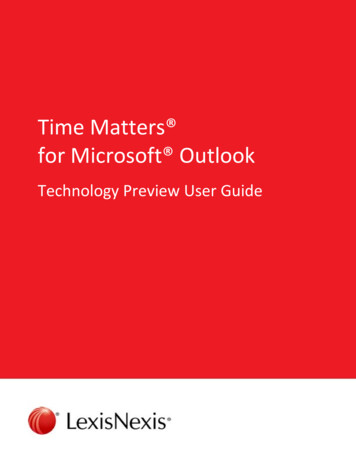
Transcription
Time Matters for Microsoft OutlookTechnology Preview User Guide
ContentsOverview of Time Matters for Microsoft Outlook . 2Requirements . 2Install Time Matters for Microsoft Outlook . 3Specify a Time Matters user . 7View the Time Matters Bar . 7Outlook Contacts versus Time Matters Contacts . 7Elements of the Time Matters Bar . 8Select a Contact to view . 9Find a Contact or Matter . 10View Contact details . 11Open a full Contact or Matter record . 13Uninstall Time Matters for Outlook . 14Reinstall Time Matters for Outlook . 14Repair a deleted or unregistered installation . 141
Overview of Time Matters for Microsoft OutlookLexisNexis Time Matters for Microsoft Outlook gives you convenient access toinformation on your Time Matters Contacts and Matters while you work in Microsoft Outlook.Time Matters for Outlook is a separate installation from the main Time Matters application. Itcreates a new tab on the Outlook ribbon, where you can show or hide the Time Matters bar.The Time Matters bar shows summary information about Contacts that appear in the emailcurrently selected in Outlook. From the Time Matters bar, you can open full Contact and Matterrecords to view additional information or make changes.RequirementsTo install and use Time Matters for Outlook, you must have: Time Matters 11.1 or later Time Matters Mobility installed and running on a server in the network A current Annual Maintenance Plan (AMP) for Time Matters The Enable Web Access check box must be selected on the Progarm Level Setupwindow in Time Matters Microsoft Outlook 2007 with Service Pack 1 or Outlook 2010 (32-bit) Microsoft Windows XP (32-bit only), Windows Vista, Windows 7, Windows Server 2003,or Windows Server 2008 R1/R2Some additional software will be installed automatically if it is not detected on the computer: Microsoft .NET Framework 4.0 Microsoft Visual Studio 2007/2010 Tools for Office Runtime2
Install Time Matters for Microsoft OutlookIf all the requirements listed on page 2 are met, you are ready to install Time Matters forMicrosoft Outlook on each individual computer where the feature will be used.Note: Time Matters Mobility must be installed on a server on your network before you installTime Matters for Microsoft Outlook. For instructions on installing Mobility, please see the TimeMatters Installation Guide.To install Time Matters for Microsoft Outlook:1. If Microsoft Outlook is currently open on your computer, close it before you begin theinstallation.2. Double-click the installation file setup.exe.3. The installation wizard detects whether required components are present on the computer. If any components are missing, the wizard will install them for you.Click Install to install the required components.3
4. The Welcome screen opens. Click Next to continue.5. Review the License Agreement in its entirety. Select I accept the terms in the licenseagreement.Click Next.4
6. If you want to specify a different destination folder, click the Change button and browseto the desired folder.Click Next.7. In the Server Name box, type the name of the server computer on which the LexisNexis Common API Service is running. Typically, the Common API is installed when youinstall Time Matters Mobility (or Mobility for another LexisNexis Practice Managementapplication).Click Next.Note: If the installer is unable to detect the Common API Service on the server youspecified, you will be prompted to type the port number where the Common API Serviceis located. This is normally port 60000 or 60001.5
8. Click Install to begin installing Time Matters for Microsoft Outlook.9. Click Finish when the installation process is complete.Next, you must specify a Time Matters user account to use with Time Matters for MicrosoftOutlook.6
Specify a Time Matters userAfter installing Time Matters for Microsoft Outlook, open the Time Matters login window. (IfTime Matters is currently open, click the File menu and then click Re-Login.)On the login window, click the Options button to display additional login options at the bottomof the window. Select the Save This Login check box. Enter the user name and password youwant to use with Time Matters for Microsoft Outlook, and click OK.While Time Matters is still open, open Microsoft Outlook. Time Matters for Outlook will detectthe current Time Matters user, whose login information you saved in the preceding step. ThisTime Matters user will be displayed in Time Matters for Microsoft Outlook.View the Time Matters BarTime Matters for Microsoft Outlook creates a new Time Matters tab on the Outlook ribbon.Select the Time Matters tab and click the Show/Hide button to show or hide the TimeMatters bar.You can collapse and expand the Time Matters bar by clicking the double arrow at the top:You can also resize the Time Matters bar to accommodate more text. Click and hold the pointerover the left border of the Time Matters bar and drag the border left to enlarge the bar.Outlook Contacts versus Time Matters ContactsTwo different sets of contacts are displayed on the Time Matters bar. Outlook Contacts are the persons or groups that appear in the header area of emails (thesender and recipients) or appointments (the organizer and attendees). Time Matters Contacts are a separate set of records, stored in your Time Mattersdatabase.When you synchronize Time Matters with Microsoft Outlook, many of your Outlook Contactsare matched to Time Matters Contact records. When contacts are matched, selecting theOutlook contact will make its Time Matters Contact counterpart available to view, along withany Matters related to it.7
Elements of the Time Matters BarThe Time Matters bar can appear in a collapsed or expanded state.When collapsed, the bar shows the following information: The currently selected Outlook contact (by default, the sender of the selected email or theorganizer of the selected appointment). The number of Time Matters Contacts and Matters related to the selected Contact. Buttons to perform a search and to show details of related Contacts and Matters.When expanded, the bar shows a full Search box and tabs for related Contacts and Matters.Collapsed barExpanded bar8
Select a Contact to viewWhen you click an email or appointment in Microsoft Outlook, the Time Matters bar displaysthe Outlook contacts for that email or appointment, and any Time Matters Contacts andMatters associated with that Outlook contact.By default, the Time Matters bar shows the sender of the email or the organizer of theappointment as the current Outlook contact. If you want to view a different contact, such asone of the email’s recipients or one of the appointment’s attendees, you can change theselected contact.To change the selected Contact:1. Click the arrow below the name of the currently selected Contact.2. A list of Contacts appearing on the email or appointment is displayed.3. Click a different Contact on the list.Note: Contacts in the Bcc field of a selected email are ignored and do not appear in the TimeMatters bar.9
Find a Contact or MatterUse the Search feature to locate a Contact or Matter by name.To search for a Contact or Matter:1. If the Time Matters bar is collapsed, click the Search button to expand it and show theSearch page.2. Type part or all of a name in the Search box.3. Select the type of record (Contact or Matter) you want to search for on the drop-downlist beside the Search box.4. Click thebutton beside the Search box to begin the search.A list of matching records appears on the Search page.5. Click an entry in the list of search results to view details for that record.To return to the Contact and Matter tabs without selecting a search result, click theSwitcher button ().10
View Contact detailsTo view Contact details when the Time Matters bar is collapsed:1. Click the Contacts button on the bar.If there is more than one Time Matters Contact associated with the current Outlookcontact, a list of Time Matters Contacts is displayed. Click the Time Matters Contactwhose information you want to view.The flyout window displays summary information for the Contact.2. To show a different Contact’s information, select the desired Outlook contact from theContacts on Email drop-down list. If there is a Time Matters Contact record for theselected Outlook contact, the flyout window will update to display the information.11
To view Contact details when the Time Matters bar is expanded:1. Click the Contacts tab.If there is more than one Time Matters Contact associated with the current Outlookcontact, a list of Time Matters Contacts is displayed. Click the Time Matters Contactwhose information you want to view.The tab displays summary information for the Contact.2. To return to the list of Contacts, click the Back button ().3. To show a different Contact’s information, select the desired Outlook contact from theContacts on Email drop-down list. If there is a Time Matters Contact record for theselected Outlook contact, the flyout window will update to display the information.12
Open a full Contact or Matter recordFrom the Time Matters bar in Microsoft Outlook, you can open a full Contact or Matter recordfor viewing or editing.To open a full record:1. Display the details of the desired Contact or Matter. If the Time Matters bar is collapsed, you can display details in a flyout window. If the Time Matters bar is expanded, you can display details on the Contact orMatter tab.2. At the bottom of the details area, click the icon corresponding to the record tab you wantto display.The Contact or Matter record form opens in a new window, displaying the tabcorresponding to the icon you clicked.13
Uninstall Time Matters for OutlookUninstalling the software will remove all files and registry entries created by Time Matters forMicrosoft Outlook.To uninstall Time Matters for Outlook:1. Close Microsoft Outlook if it is currently open.2. Open the Windows Control Panel.3. Double-click Add or Remove Programs.A list of installed programs appears.4. Locate Time Matters for Microsoft Outlook in the list and click it.5. Click Remove. When prompted to confirm that you want to remove the software, clickYes.Reinstall Time Matters for OutlookYou might need to reinstall Time Matters for Outlook under circumstances such as these: You have removed the Time Matters add-in from Outlook using the Outlook Add-inManager. You have moved to a different version of Microsoft Outlook, such as from 2007 to 2010or from 2010 to 2007.To reinstall the software, simply run the setup file tmosetup.exe again.Repair a deleted or unregistered installationIf the Time Matters for Outlook add-in is deleted, you will need to repair the installation. Thiswill reinstall Time Matters for Outlook in its original location and restore its registry entries.To repair the installation: Click the Windows Start menu, click All Programs, point to LexisNexis, point to TimeMatters for Microsoft Outlook, and click Repair Add-In.If the Time Matters for Outlook add-in becomes unregistered, you will need to re-register it.To register the add-in: Click the Windows Start menu, click All Programs, point to LexisNexis, point to TimeMatters for Microsoft Outlook, and click Register Add-In.14
Time Matters Mobility installed and running on a server in the network A current Annual Maintenance Plan (AMP) for Time Matters The Enable Web Access check box must be selected on the Progarm Level Setup window in Time Matters Microsoft Outlook 2007 with Service Pack 1 or Outlook 2010 (32-bit)

